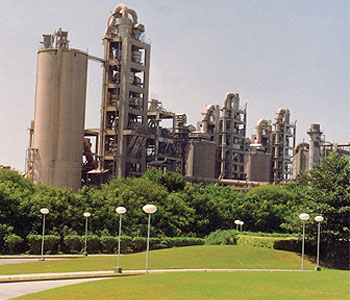Reduce that waste line
12 June, 2014 | Manufacturing Today
Share Manufacturing Today
June 2014
The energy cell at Aditya Birla UltraTech Cement through its waste heat recovery system ensures that all its cement plants are on the path to sustainability

Focusing on energy conservation methods, specially in the cement industry becomes necessary as it is among the energy intensive industries. With energy contributing to over 28% of UltraTech Cement's cost of production, the focus is on energy conservation. The organisation has a dedicated cell to track energy consumption across the Group companies.
Elucidating, Rajasekar Lakshmanan, executive president, Technology &Research Centre, UltraTech Cement Ltd avers, "The role of the cell is to monitor energy footprint and explore avenues to reduce the same. We c;reated a separate energy cell two years ago with an objective to monitor energy consumption and explore opportunities for improvement."
UltraTech currently has 11 integrated plants, 11 grinding units and five bulk terminals within India. There are plants in Sri Lanka, Bangladesh, and UAE too, and the cell primarily supports the Indian operations, across the grey cement business of UltraTech. Though the cell operates from Mumbai, there are energy conservation teams at each units, duly supported by respective senior management.
"At the corporate level, the task is mainly to identify potential cost effective energy conservation initiatives, identify units where the same could be a best fit, taking the medium to long term perspective with due regard to quality, safety and environment norms," says Biswajit Dhar, senior vice president, Technology &Research Centre, UltraTech Cement Ltd.
Any reduction in energy consumption has a direct bearing on cost, as well as on the sustainability by way of reduced dependence on natural resources and reduced emissions. As a specific case, a replacement from a conventional clinker cooler to a state-of-the-art, duly sized clinker cooler could result in a saving of 30-40 kcals/kg clinker and about one-two kwh/t clinker. "This means a saving of about 5-6% directly in fuel consumption and about 2% direct reduction in power consumption. Added to this are some consequential benefits like lesser coal grinding, lesser combustion air, lesser gas handling and emission control requirement resulting again in reduced power, emissions and cost," asserts Rajasekar.
A similar case had taken place in one of their plants at Tamilnadu where the energy footprint was 850-860 kcal/per kg. After changing the cooler and some a;lterations at pre-heater, the footprint was brought down to 760 kcals/kg clinker. "The new cooler has also brought about a reduction/elimination of water consumption which again helps towards the cause of sustainability, beside cost," puts in Dhar.
Apart from the above, various other cost effective measures for energy conservation like increased usage of alternate fuels, in house vigilance to curb leakages, efforts to improve fly ash and slag absorption, investment in Variable Speed Drives (VFDs), progressive phasing out of low efficient drives, utilisation of Computational Fluid Dynamics (CFD), etc are taken up by the energy efficiency cell to reduce pressure d;rop and thus the power consumption.
Waste Heat Recovery (WHR) process is an excellent method for a plant to improve energy efficiency. Reducing the amount of wasted heat as well as reusing it has been a matter of great concern for the past couple of decades. Conventionally, all cement plants primarily focus on minimising waste heat generation through maximising operational efficiency, correct sizing of equipment, s;election and processing of raw materials and fuels, proper lining and insulation to reduce radiation losses, etc. The gases mainly from kiln stack and cooler, with temperatures generally varying from 270°C to 330°C are partly used for drying of raw material and fuel and the excess is vented into the atmosphere.
— Ratan Shah, chief manufacturing officer, UltraTech Cement Ltd
Agreeing, Rajasekar adds, "Of course, in some of our plants, we use part of the residual gases for drying of slag or fly ash which are required for manufacturing of Portland Pozzolana Cement (PPC) and Portland Slag Cement (PSC) respectively. Depending on the drying needs of the plant, which in turn, depends on the moisture content of the raw material, coal, flyash, slag, etc. the percentage usage of hot gases may vary significantly. In other words, plants with high drying requirements have relatively lower potential for waste heat recovery and vice versa."
Moreover, the present generation of pre-heaters has relatively high thermal efficiency and consequent lower exit temperatures. "Thus, the excess low quality gas, over and above drying requirements, as stated above, was vented into the atmosphere, except in some specific instances where it is used for cement mill operation. At one of our plants, the cooler exit gases are being used for desalination of sea water to cater to the water demand of the plant," avows Dhar.
With improvements in technology, increased cost of power, and the pressing need to reduce energy and CO₂, footprint, waste heat recovery has now emerged as an option. However, the challenge lies in integrating a system for the waste heat recovery into the industrial site without affecting the process. And this is exactly what Aditya Birla UltraTech Cement has successfully done. The company is in the process of installing waste heat recovery plants where viable.
"Rising energy prices and depleting energy sources are a major challenge for industrial plants. At UltraTech Cement, we are always looking for technologies and solutions that can lower our environmental footprint as well as be economically viable. Industrial waste heat is an underutilised source of clean energy," emphasises Ratan Shah, chief manufacturing officer, UltraTech Cement Ltd.
He states that waste heat recovery is not only the cheapest source of energy but it also reduces the carbon footprint. "WHR systems are now part of all our new plants. In the next three years, we hope to generate 100 MW of WHR power, making our business more sustainable," adds he.
— Biswajit Dhar, senior vice president, Technology &Research Centre, UltraTech Cement Ltd
Likewise, power generated through a waste heat recovery process, reduces specific fuel consumption as the same is generated without using any fuel. "Thus, this helps in reducing energy and CO₂, footprint, etc. thereby supporting our sustainability drive. We are in the process of installing waste heat recovery systems at few of our cement plants, some of which are at an advanced stage of erection or commissioning. One such installation at APCW has been successfully operating since the last five years," asserts Dhar.
All cement plants usually try using the waste heat available to offset their drying requirements, in house and only the extra heat available could be used for waste heat recovery or other productive use, depending on the quality and quantity of heat available.
Explaining the process Dhar says, "The hot gases that are released after the cement manufacturing process are at temperatures ranging from 270°C to 400°C depending on the number of stages of the pre-heater. The cooler exhaust is at about 300°C. A cement plant has relatively higher volumes of exhaust gases but the exit temperature being lower, heat transfer efficiency is low and this results in relatively higher capital expenditure. In a boiler, if water is used as the medium for heat recovery, the exit temperature is 160°C. Therefore, considering that the gases coming out of the plants are at 270°C heat available for recovery is around 100°C — Higher the inlet temperature, higher the efficiency of conversion. Typically anything below 160°C cannot be recovered, in a cost effective way."
— Rajasekhar Lakshmanan, executive president, Technology &Research Centre, UltraTech Cement Ltd
Therefore, the key parameters to find the potential ways to c;reate value from recovered heat could be "the volume and temperature of the extra gases available, residual life of the plant, space availability to enable easy integration with the existing plant and a cost effective proposal, based on lifecycle costing, payback, etc," affirms Rajasekar.
There are three processes to recover heat from waste – Conventional steam cycle, ORC and Kalina cycle. Each has its own pros and cons. "The efficiency is the best in the Kalina cycle but there are problems associated with handling Ammonia. ORC falls somewhere in between with it being equally safe and efficient. Steam is the safest way to recover heat but the efficiency is low and one cannot recover low heat," declares Dhar.
The group commissioned a Kalina cycle plant recently in UAE and it is the second of its kind in the world. This method works best, because the country faces scarcity of water and with this technology though there needs to be a water mixture there is no need for top up. "Today, we have one Kalina cycle plant, one ORC plant, three or four steam cycle based plants, which are under the commissioning stage," affirms Rajasekar.
In other words, s;election of an appropriate initiative, tailored specifically to the requirements and limitations of a plant, viewed from a long term perspective holds the key to the success of the project. "There is a certain degree of uniqueness with each cement plant and hence a success story at one plant need not necessarily be a success at another. Therefore, there is a necessity to carefully study the pros and cons of the proposal in question, before finalising a decision," opines Dhar.
While companies are doing their bit to become energy efficient, both the industry veterans believe that the Indian government too should contribute to the cause like that of the Chinese. They are of the opinion that it should offer sops in terms of subsidies, tax concessions to encourage the cement industry.
"To make WHR a success we need to give some incentives to improve the payback. Also, WHR should be included under renewable energy obligations. I think, with adequate support from the government, initiatives such as WHR and many others on similar lines shall get a much needed boost and we can definitely look at the industry becoming much more efficient and that will aid us to stand out globally," stresses Rajasekar on a concluding note.






